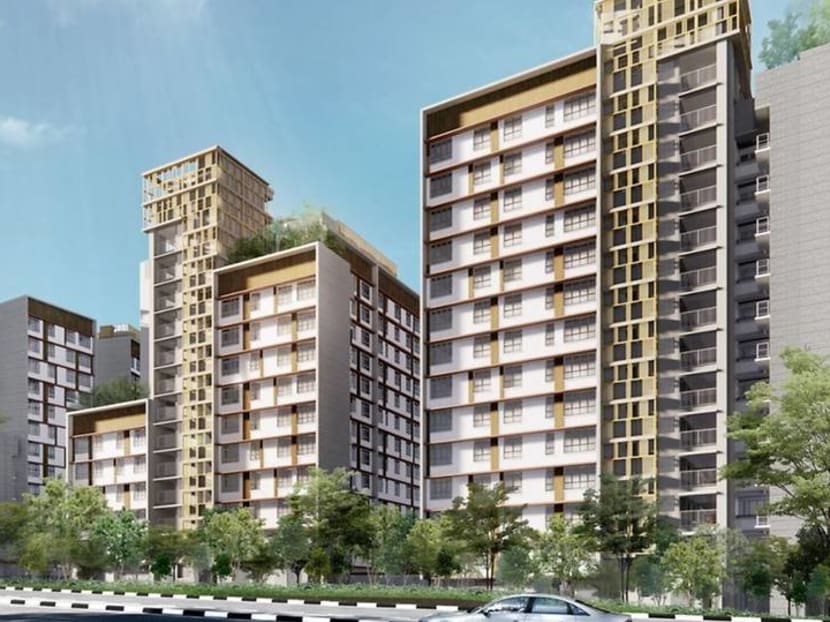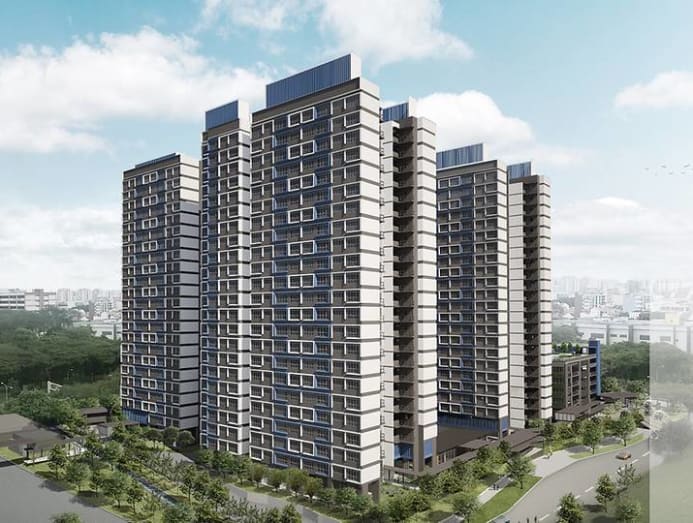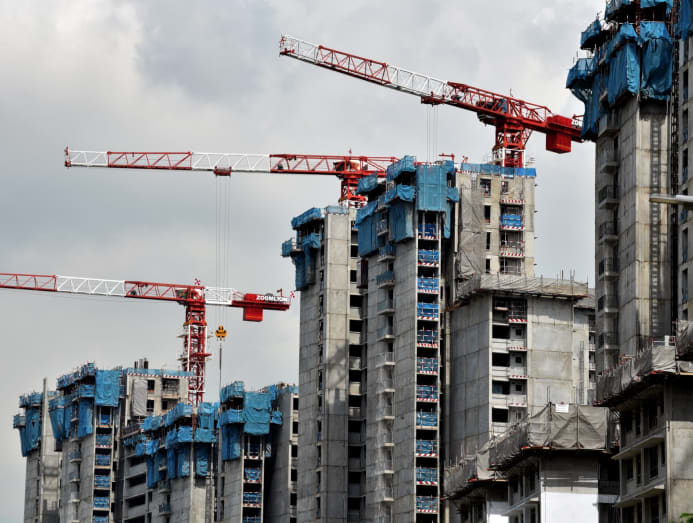commentary Commentary
Commentary: Is housing still affordable for first-time homeowners?
While city centre BTO flats can be pricey, a look at flats across the island indicates why choice determines affordability, says Sing Tien Foo.

HDB launched its first BTO exercise for 2021 on Feb 4. They include flats in both mature and non-mature estates, including Park Edge@Bidadari. (Photo: Facebook/Desmond Lee)
SINGAPORE: Singapore has one of the highest home ownership rates in the world. Today, every nine in 10 public housing dwellers own their flats in Singapore.
The Home Ownership Scheme introduced in 1964 has been one of the key pillars underpinning Singapore’s public housing system, which is enviable to many countries facing acute housing shortage problems.
But COVID-19 is throwing up new challenges and created a few jolts to the housing market.
READ: BTO projects expected 'to be delayed' by a year or more due to tightened COVID-19 border measures
Pent-up demand due to the cancellation of BTO launches during the circuit breaker and delays in completion of BTO flats shifted part of the demand away to the resale HDB market.
This in turn saw a surge in the resale HDB prices by nearly 7.6 per cent over the three consecutive quarters since the reopening of economy in 2020. The private market also saw similar spikes.
HOUSING AFFORDABILITY
A key question that has arisen from this news is the affordability of BTO flats.
In particular, netizens have asked if the income growth of young people has kept up with these rising prices in the public and private markets.
They point to housing prices growing at a pace outstripping income growth. From 2001 to 2020, BTO flat prices (at the upper range) of 4-room and 5-room units have gone up by 2.4 times from $208,250 to S$496,760, on average, whereas the median income of employed residents has increased by 1.95 times from S$4,716 to S$9,189 over the same period according to the data from Department of Statistics.
They also point to the annual compounded growth, where the average BTO price (4.4 per cent) outgrew the monthly household median income (3.4 per cent) by approximately 1 percentage point over the 20-year period.
I would argue however that housing affordability should look at more indicators to get a clearer picture. The price to income ratio (PIR) for example, tells a more nuanced story.

Zooming out, research by my colleague Associate Professor Lee Kwan Ok and two economists from the Asia Development Bank, estimated an average PIR of 13.3 for a sample of 211 cities in 27 developing countries in Asia.
READ: Commentary: Why Singapore's private residential market will remain attractive in the long term
Compared to the average PIR of 4 estimated for developed countries by Demographia International Housing Affordability Survey (2019), housing in these Asian cities is severely unaffordable.
In comparison, Singapore’s average PIR ratio of 4.1 for 4- to 5-room BTO flats in the last 20 years from 2001 to 2020 is within a reasonable range of affordability. The ratio is even lower if you take into account the various CPF housing grants for first-time homeowners.
Currently, these grants ranging from S$5,000 to S$80,000 will be given to HDB buyers with monthly household income of below S$9,000.
The increase in the average BTO flat prices and also the drop in the median household income in the post-COVID period has contributed to the rise in the PIR ratio. So, affordability has declined marginally in 2020 compared to the pre-COVID ratio of 4.1 in 2019.
It is worth noting that while the average PIR measures the overall affordability level for BTO flats in Singapore, the PIR is higher in mature estates and bigger flats.
BTO FLATS IN POPULAR MATURE ESTATES
Which brings us to the question of those desiring a BTO in highly popular mature estates. Many who gravitate towards these flats because of the location, amenities, and closeness to transport nodes and malls will have to accept that those flats will inevitably be more expensive.
For example, in the May 2019 BTO launch, high-floor 4-room units in the Kempas and Boon Keng BTO projects located in the popular Kallang-Whampoa estates were priced up to S$674,000.
Yet these BTO flats saw subscription rates as high as 12.89 times, where only one out of 13 applicants were able to buy a unit of the 3- to 4-room type.
READ: Commentary: If your BTO flat is delayed, staying with parents or in-laws isn’t a bad idea
The connectivity to MRT and also the proximity to good schools also draw keen interests of Singaporean couples.
For the two BTO launches in November 2020, Bartley Beacon located near Bartley MRT station on the Circle Line and ParkView@Bidadari near the Woodleigh and Potong Pasir MRT stations on the North-East Line were oversubscribed by 4.978 times, despite an indicative price range of between S$466,000 and S$726,000 for 4- and 5-room flats.
In the latest launch of Telok Blangah Beacon that is close to the future Greater Southern Waterfront, 4-room flats were oversubscribed by first timers by nearly 28 times.
For second timers, the chance of getting a flat was even bleaker given more than 412 applicants vying for one available unit there. Even if the applications were successful, buyers will still have to pay between S$602,000 and S$710,000 for 4-room flats and wait for more than five years for the project completion.
So, despite the higher prices, buyers still want these flats. Other than the attractive locations being near the central region and connected to key transport nodes, the limited supply of new BTO flats and future price appreciation also contribute to the strong demand in the area. In other words – this is a worthy investment to make for a flat in a good location.

OVERSUBSCRIPTION IN BTO FLATS
Based on the statistics collated on BTO launches since 2011, the oversubscription rates in the popular housing estates, like Bidadari, Ang Mo Kio, Kallang/Whampoa, Bedok, Bishan, Toa Payoh and Clementi, were estimated at nearly six times and above, on average.
READ: Commentary: How much should young couples spend on their first home?
The preference may be for both location and a certain amount of space too. Woodleigh Glen and Woodleigh Village were the most keenly competed BTO projects, where 3-room and bigger units recorded an oversubscription rate of nearly 33 times in 2016.
In comparison, smaller 2-room flats in Fernvale Riverwalk in Sengkang were nearly 25.6 times oversubscribed when launched in 2013.
Couples know they have other more affordable options. After all, BTO flats in further flung neighbourhoods - in Sembawang, Yishun, Bukit Batok and Punggol - are priced much lower. In the November 2020 BTO launch, 3-room to 5-room flats in Sun Sails projects at Sembawang were priced between S$163,000 and S$388,000.
In the November 2020 released batch of BTO flats, a 4-room flat in the new Tengah district will cost from S$243,000 after grants while the same size flats in non-mature estate in Chua Cho Kang will cost from S$193,000 after grants. So, it boils down to a question of choice.
(Are cooling measures on the cards after four quarters of price increases in the residential property market? CEO Propnex Ismail Gafoor and NUS Institute of Real Estate Studies Dr Lee Nai Jia give on their take on CNA's Heart of the Matter podcast)
MOVING INTO PRIVATE HOMES
There has also been talk about whether young couples are priced out of the private housing market.
After all, moving up the housing ladder from public housing flats to private houses, either landed or non-landed, is the aspiration of many young couples.
Yet let’s not forget that public housing flats form a rock-solid base where nearly 1.08 million public housing flats currently serves the housing needs of more than 78 per cent of Singapore residents.
The jump can be steep. If a young family wants to upgrade to a condominium with sufficient rooms for kids, they will have to set aside about S$1.6 to S$1.7 million on average.
Let’s say a couple has a monthly combined income of S$12,000. Financing a condominium valued at S$1.7 million will need a 25 per cent down-payment of S$425,000.
Unless there is financial help from parents, many young couples, in many instances, will find it hard to fork out such a big sum of cash, assuming already that stamp duties and legal fees can be covered using their CPF.
When you consider the mortgage costs, applying a conservative estimate of a 20-year fixed rate mortgage at the maximum of 75 per cent of the property value, and at an interest rate of 2.0 per cent per annum (monthly rest), a couple will have to bear a monthly mortgage payment of about S$6,450.
READ: Commentary: COVID-19 will reshape the Singapore office property market outlook
Some of this can be offset with monthly CPF contributions, but still leaves the couple with a cash payment of around S$3,690 per month, which makes about 30.75 per cent of their gross combined income.
All things considered, public housing is still the most affordable housing option for many young couples in Singapore. But it also means they must adjust their expectations especially if they aspire to have private apartments.
And if they want homes near the city centre, they must be able to pay a higher price.
Professor Sing Tien Foo is Director at the Institute of Real Estate and Urban Studies (IREUS) and Head of Department of Real Estate, National University of Singapore. The views and opinions expressed herein are those of the authors and do not represent the views and opinions of the National University of Singapore or any of its subsidiaries or affiliates.





